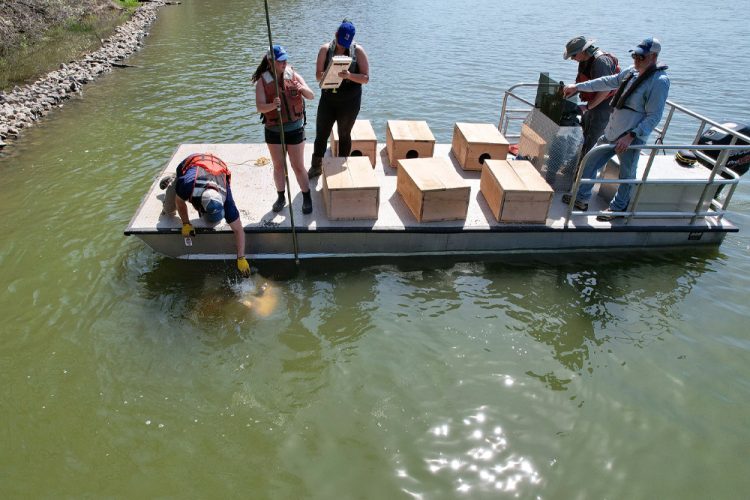Crews installed the channel catfish spawning boxes in Illinois’ lakes Mattoon,
Paradise and Charleston in June. Photo courtesy of Illinois DNR
Nesting Boxes Aim to Boost Illinois Catfish Populations.
By Keith “Catfish” Sutton
In a promising new conservation effort, approximately 150 wooden spawning boxes have been placed in three Illinois reservoirs—Lake Mattoon, Lake Paradise, and Lake Charleston—to improve the natural reproduction of channel catfish. This initiative is a collaborative project between Eastern Illinois University’s Center for Fisheries and Aquatic Sciences and the Illinois Department of Natural Resources (DNR) Division of Fisheries.
A Habitat Solution for a Habitat Problem
Channel catfish, one of the Midwest’s most popular gamefish, naturally spawn in cavities such as hollow logs, stumps or undercut banks. However, in many aging reservoirs, this type of critical habitat is in short supply. The absence of suitable nesting sites can lead to low recruitment, meaning fewer young catfish survive to adulthood. As a result, fishery managers often have to rely on costly and continual stocking to maintain sustainable populations.
That may soon change.
The recently deployed catfish spawning boxes, originally designed and tested in Pennsylvania, offer a potential solution. These artificial nesting structures are designed to mimic the natural cavities that catfish prefer for reproduction. Once inside, the female lays eggs, which the male then fertilizes and guards until they hatch.
“This effort is all about supporting natural processes,” said a spokesperson from the Illinois DNR. “If successful, these boxes could help increase natural recruitment and reduce our reliance on artificial stocking.”
A Community Collaboration
The project is also a shining example of community-driven conservation. The spawning boxes were constructed through a collaborative outreach effort involving Scout Troop 141 (led by Eagle Scout candidate Hunter Grabiec), Construction Management students at EIU, and Fisheries and Aquatic Sciences graduate students and faculty. The box-building was supervised by Professor Isaac Slaven from Eastern Illinois University.
“This was more than just a fisheries project,” said Slaven. “It was a hands-on educational opportunity that brought together students, Scouts and scientists for a common environmental goal.”
Science in Action
Now in place beneath the surface of these three reservoirs, the spawning boxes will be closely monitored throughout the summer spawning season. Researchers at EIU have already collected baseline data on the lakes’ catfish populations in the years leading up to this deployment. By comparing future data, they’ll be able to assess whether the boxes are being used and whether recruitment improves.
“This is a long-term project,” said EIU researchers. “We’re looking forward to sharing updates after the spawning season ends. The ultimate goal is a healthier, more self-sustaining catfish fishery.”
Looking Ahead
While the results won’t be known immediately, the potential impact of the spawning boxes is significant. If they work as intended, anglers may see stronger catfish populations in years to come—and fewer tax dollars may be needed to stock them artificially.
For now, the team behind the project is hopeful. By combining habitat restoration with grassroots involvement, this initiative is helping to ensure that Illinois waters remain productive, enjoyable fishing destinations for generations to come.



